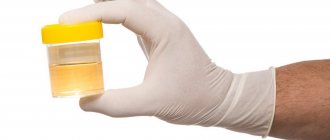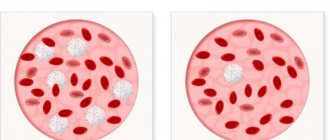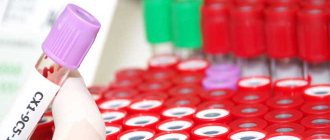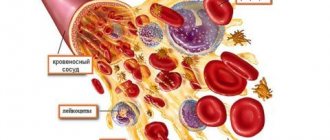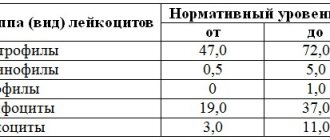Spermogram indicator standards
Why exactly does the level of leukocytes need to be monitored during a spermogram?
Everyone is well aware that leukocytes are present in human blood, acting as the body’s protectors against viruses and microbes.
But in the male body, these white cells are also found in sperm. An excessive increase in leukocytes in the spermogram indicates the penetration of an infection into the male genital organs, causing inflammation.
The leukocyte count is important information that allows the doctor to select further diagnostic and therapeutic measures.
There are cases when the number of leukocytes in the spermogram is overestimated even without the presence of infection in the body.
This is possible in cases where underdeveloped sperm are perceived in the analysis as white blood cells.
To prevent such an oversight and provide accurate spermogram results, doctors use special dyes that have different effects on cells of different nature.
A certain norm for the number of leukocytes in the spermogram has been established, which is acceptable for the male body.
There are two variations of the norm used to obtain test results:
If an excess of the standard number of leukocytes is detected, the doctor makes a diagnosis of the development of a sexually transmitted infection with an accompanying inflammatory process.
The negative effect of an increased number of leukocytes is damage to sperm. Their activity is minimized, which is why they are not able to reach the female egg and ensure the beginning of the fertilization process.
In rare cases, a delayed sperm still fertilizes the egg, but leads to even more serious consequences.
Elevated leukocytes on the spermogram is the likelihood of sperm mutation at the gene level under the influence of infection.
Transmission of such an infection during fertilization can result in miscarriage or serious developmental disorders of the fetus. The likelihood of having a healthy child in such circumstances is negligible.
Inflammation can begin to form dangerous biologically active substances in the body that damage or completely destroy the membrane of a living sperm.
With a low concentration of these substances, the likelihood of problems with conception is low, but in the absence of timely treatment, the number of leukocytes increases, which is why pregnancy does not occur.
Video:
Another option for the negative impact of a high level of leukocytes is an overgrowth or dangerous narrowing of the vas deferens.
Due to the created obstacle, sperm cannot leave the ducts and enter the woman’s body. Accordingly, fertilization and pregnancy become impossible.
Additional diagnostics
An increased content of leukocytes in the spermogram only indicates the presence of inflammation. However, the doctor needs to determine the localization of the pathological process. To select the most effective drugs, it is also important to identify the type of pathogen. In order to clarify the diagnosis, the man is prescribed additional examinations:
- urine analysis (general and bacterial culture);
- smear from the urethra (for the presence of bacteria and their sensitivity to drugs);
- Ultrasound or MRI of the prostate, bladder and external reproductive organs;;
- cystoscopy;
- urethrography.
Explanation of results and treatment measures
Before submitting biomaterial to the laboratory, special preparation is required. Based on the data obtained, the urologist prescribes treatment and monitors the results.
Submission of analysis and decoding
The analysis is carried out after sexual abstinence (2-3 days, but not more than seven days). First you need to go to the toilet and empty your bladder. Five days before the procedure, you should abstain from sexual intercourse and not visit the bathhouse, sauna or other places with high temperatures. If you need to take medications, you should notify your doctor.
The collected sperm is placed in a sterile container and sent to the laboratory at room temperature. The study is carried out no later than 30-40 minutes after sperm collection.
Research technique:
- Determination of macroscopic appearance (shade, transparency, impurities, odor, consistency and quantity).
- Microscopy examines the concentration of sperm, their structure, external shape, mobility, as well as the presence of red blood cells and leukocytes in the sperm.
- Ultrasound of the prostate.
- Sperm culture.
- Diagnostics using PCR and ELISA methods.
- Urethral smear.
- Hormonal examination.
An increased content of leukocytes does not leave any indicator characterizing the quality of seminal fluid without deviations. In various diseases, the presence of red blood cells and a change in the acidic environment are possible.
Much depends on the period or duration of the disease, since in the acute period the indicators remain normal and change as the body’s reaction to inflammation increases.
Therapy and prevention measures
After examining the patient, the doctor prescribes special therapy to eliminate the main cause of the increase in white blood cells. Drug treatment with drugs is required: antiviral, antibiotics and anti-inflammatory drugs.
The most commonly prescribed antivirals are Acyclovir and Viferon, and antibiotics are represented by Tetracycline, Azithromycin or Ampicillin. At the same time, biological supplements (Spermactin, Speman, Viardot, Selenium, folic acid), physiotherapy for the pelvic organs, proper nutrition, and diet are prescribed. Alcoholic drinks, smoking, as well as heavy physical labor or sports activities are prohibited.
Anti-inflammatory drugs Nise, Nimesil, Nimesulide, Ibuprofen are prescribed only under the supervision of a doctor in a specific dosage.
A man should perform exercises on the muscles of the perineum every day, this will increase the outflow and movement of blood and improve metabolic processes. Maintaining a daily routine (healthy sleep and rest), sexual rest throughout the entire treatment, food should be balanced with protein foods.
The recovery course depends on the level and degree of infection of the patient. Chronic pathology takes longer to eliminate. There must be constant medical supervision and study of the dynamics of treatment. At the end of the therapeutic course, a semen analysis is performed.
Treatment with folk remedies does not always eliminate the root cause of the disease, but has an additional effect. Using available forms, inflammation is eliminated, symptoms and disease progression are reduced, and metabolic processes are improved. It is necessary to consult a doctor about the use of traditional medicine methods.
To reduce the risk of leukocytospermia, you need to avoid sexual contact with girls you don’t know, use contraceptives, take vitamins and minerals in the off-season, play sports and lead an active lifestyle. A man should not overcool or overheat. After eliminating the root cause of the bad tests, the new results will be normal.
Spermogram: normal indicators
It is this study that shows one or another deviation of sperm. The main rule for preventing distortion of results is preparation and correct collection of material.
Recommendations:
- Lack of intimacy 4-5 days before the study;
- Do not visit places with high temperatures (sauna, bathhouse);
- Refusal from alcohol and nicotine on the eve of the test;
- When taking medication, tell your doctor;
- Intimate hygiene before the procedure;
- Rest and no physical activity the day before.
Choose a reputable laboratory with good reviews. If you do not like the first results, you need to undergo the procedure again after 2.5 weeks.
You can change the laboratory assistant who reads the results, or the laboratory itself. If 2 independent figures showed the same indicators, then there should be no doubt about the diagnosis and treatment should begin.
What does an embryologist look for when examining ejaculate:
- Mobility;
- Sperm morphology;
- The ratio of the number of living and dead in 1 ml of seed;
- The presence of leukocytes and erythrocytes in the ejaculate.
Along with a spermogram, you need to undergo a thorough examination, undergo many tests and diagnostics.
- For hidden sexually transmitted infections, HIV, syphilis;
- Urethral smear;
- Ultrasound of the pelvic organs and prostate gland;
- For hormones.
Timely treatment of infertility increases the chances of natural conception. Therefore, if you are unable to conceive a child over a long period of married life, you should think about a sperm examination.
Spermogram norm indicator table
| Name | Decoding |
| Volume V | 2.5-4 ml |
| pH (Acidity) | 7,0-8,0 |
| ductility | 1.5-2.0 cm |
| Liquefaction | About 1 hour |
| Number of sperm in 1 ml | >20 million |
| The number of living creatures in the total ejaculate | 600 million |
| Energy | Cat.A (movable) >50%; Cat.B (low-moving straight trajectory) = 25%; Cat.D.(inactive with bad trajectory)=25%; Cat.C (real estate) = no more than 15%. |
| Morphology | >40% |
| Alive | >50% |
| Agglutination (clumping) | No |
| Leukocytes | the norm in the spermogram should be 2-3 in the field of view |
| Red blood cells | No |
| Spermatogenesis and its cell state | 4% |
If your spermogram shows abnormalities, do not despair. Each decoding is individual, and accordingly, treatment will be aimed specifically at the underlying disease.
Reasons for the increase in leukocytes in sperm
They exist in every body, and within normal limits they are responsible for the immune system and fight many viruses and harmful microorganisms. Elevated leukocytes in the spermogram in men can indicate either minor inflammation or a serious disease of the genitourinary system.
In addition to the main indicators that the doctor looks at in the spermogram, leukocytes are one of the informative ones. Thanks to them, the cause is determined and conservative treatment is prescribed.
If the leukocytes in the spermogram are elevated, it is worth taking the test again after 2.5 weeks. Perhaps an inexperienced laboratory technician or a medical mistake (and this happens) or they confused leukocytes with immature sperm.
The main reasons for high concentration:
- STD. If sexually transmitted diseases are not identified and treated in time, all this will lead to a chronic form and, accordingly, to an increase in the norm of leukocytes, and subsequently to infertility. Such diseases include: gonorrhea, trichomoniasis, chlamydia, syphilis;
- Inflammatory processes of the prostate gland. The main male organ, which produces semen secretion and supplies sperm with motility and vitality, regulates the production of the main male hormone - testosterone. An increase in leukocytes means adenoma and prostatitis;
- Diseases of the genitourinary system (urethritis, vesiculitis);
- Pathologies of the testicles, scrotum, seminiferous tubules (orchitis and epididymitis). Any abnormal processes in these organs lead to the death of sperm.
Leukocytospermia in men and conception
The main question that concerns young couples is whether it is possible to conceive a child with such a condition? With such a diagnosis, it is unlikely that a woman will be able to get pregnant, even if a miracle occurs, you should not count on an easy pregnancy or the birth of a healthy baby.
Therefore, it is urgent to start conservative treatment and not plan pregnancy at this time. In addition to infertility, a man may experience health problems, such as narrowing of the urethral canal and seminiferous tubules.
Treatment
After examination, therapy is aimed at eliminating the root cause. Often these are the following groups of drugs:
- Antiviral: “Viferon”, “Acyclovir”;
- Antibacterial: “Tetracycline”, “Oxytetracycline”, “Ofloxacin”, “Azithromycin”, “Ampicillin”, “Gentamicin”;
- Anti-inflammatory.
The course of recovery depends on the degree of damage and infection. The chronic form of any pathology is eliminated over a long period of time. Treatment of reproductive function should be carried out under the supervision of doctors.
At the end of the course, a repeat sperm diagnosis is scheduled. This will help evaluate the effectiveness of the chosen therapy. Tactics will also change if they do not produce positive results.
At the same time, the following is prescribed:
- Vitamins (dietary supplements): “Spermactin”, “Sperma Plant”, “Speman”, “Tribestan”, “Viardot”, “Indigal plus”, “Selenium”, “L-carnitine”, “Folic acid”;
- Physiotherapy. Light exercises that are aimed at increasing blood circulation in the pelvis will help improve spermatogenesis and increase the activity of livestock;
- Diet therapy. Proper nutrition with sufficient protein, vitamin E, zinc, which will help improve the quality of ejaculate and strengthen the body’s protective functions;
- Refusal of bad habits and hard physical labor.
By following all the doctor’s instructions, taking vitamins, playing sports and giving up nicotine and alcohol, you can conceive the long-awaited child. Subscribe to our website. Find out a lot of useful information. Be healthy!
source
Preparing for sperm collection
In order for the results of sperm analysis to be reliable, you should not neglect the preparation rules.
As part of the preparatory measures, the following recommendations must be followed within 7 days:
To refuse from bad habits. Alcohol and prohibited substances destroy the entire body, including germ cells. Bad habits affect mature and growing germ cells and impair the functioning of the gonads. Maintain the correct temperature. Thermal effects on sperm greatly affect their structure, reducing motility. You will have to avoid thermal procedures and sunbathing for a while. Body temperature should not exceed the barrier of 38°C. Avoid stress. An increase in prolactin, caused by emotional and physical overload, negatively affects the human reproductive system. Prolactin inhibits the activity of the sex glands, thereby affecting the quality of semen. Eat properly. Including pomegranates, apples, bananas, nuts, asparagus, garlic and tomatoes in the diet has a positive effect on sperm motility
It is important to exclude salted and smoked foods. Refuse sexual activity. The fact is that with short-term abstinence, not all processes in the body are completely reflected in the quality of sperm
The release of ejaculate 1 or even 5 days before the test affects the truth of the result. Stop medications. Antibiotics and some other groups of drugs have a negative effect on growing and mature sperm, therefore at least 75 days must pass since the last dose of the drug - the period of full spermatogenesis.
It is necessary to create replacement fluid and carry out sampling yourself in a specially designated room. No more than 3 hours should pass from the moment of ejaculation to the analysis, since the reliability of the results after this period is questioned. Some laboratories allow semen collection outside the institution's walls.
The norm and deviations from it
The presence of red blood cells in sperm is a deviation.
According to the standards of the World Health Organization, red blood cells should not be present in semen in principle. If they are present in the ejaculate in any quantity, this is no longer normal; this condition is called hemospermia.
However, it is the number of red blood cells and the frequency of occurrence of the problem that help differentiate the pathological process from everyday or accidental causes of the presence of blood in the semen.
Single inclusions of red blood cells in the absence of other symptoms do not indicate the presence of pathology and are considered a conditional variant of the norm.
This is the so-called false hemospermia, which can occur due to several reasons:
- 1-2 blood cells can enter the ejaculate due to accidental damage to small vessels.
- 1 or more red blood cells in the ejaculate can be diagnosed when a man receives trauma or mechanical damage to the genital organs. Including during sexual intercourse.
- One or more blood cells often appear in semen after a period of prolonged sexual abstinence.
- Often 1 or more red blood cells enter the semen from the partner's vagina during unprotected intercourse.
If the results of the analysis indicate that there is one or a pair of fresh red blood cells in the sperm, it is necessary to do a repeat spermogram after some time. It is advisable to do the analysis three times in a row with a break of 7-10 days. This way, the attending physician and the man himself can make sure that the appearance of blood in the ejaculate is an accident and has nothing to do with diseases of the genitourinary system.
When taking tests, you must adhere to special rules.
In some cases, the diagnosis of a small number of red blood cells in the ejaculate occurs due to a man’s banal failure to comply with the rules of preparation for laboratory analysis. For example, if a man did not abstain from sexual intercourse three days before sperm donation, or had heavy physical activity on the eve of the spermogram. If any medical manipulations took place before the test, this may also affect the results of the spermogram. Some blood may remain in the semen for 1-4 weeks after a prostate biopsy or vasectomy.
Therefore, repeated and all subsequent spermograms must be done, strictly observing the preparation rules and following the doctor’s recommendations. If even minor deviations from the norm are detected regularly, this indicates not false, but true hemospermia.
Treatment
After identifying the reasons that led to an increase in the number of leukocytes in a man’s seminal fluid, the doctor must determine how to treat leukocytospermia.
One of the main tasks of diagnosis is to identify the causative agent of inflammation and test its sensitivity to different groups of antibiotics. Based on the results of this analysis, the doctor prescribes the patient a course of antibacterial therapy, in other words, antibiotics. That is why self-medication is unacceptable; it should be prescribed and monitored by a doctor with appropriate education.
Depending on what kind of disease has been identified, uroseptics may be prescribed, which neutralize inflammation in the organs of the genitourinary system and speed up recovery.
Considering the fact that in most cases leukocytospermia does not cause any changes in the well-being of patients, no special regimen is required. However, in exceptional cases, if the clinical picture includes an elevated temperature, the doctor may recommend the patient not only bed rest, but also hospitalization in a hospital.
One of the specific recommendations for effective treatment is daily ejaculation
It is very important to remember the need for a barrier method of contraception until the end of treatment
The speed of the healing process always depends on the state of the immune system and the general tone of the body. One of the surest and easiest ways to help the body fight inflammation is diet. Nutrition during treatment should be as correct and balanced as possible. It is useful to eat foods rich in zinc, such as: beef, beans, nuts, parsley, cilantro.
The prognosis of treatment in most cases is favorable. But if the patient consults a doctor late, and inflammation has already caused the formation of a tissue abscess, the help of a surgeon may be required.
What do red blood cells mean in a spermogram?
An increase in red blood cells in the spermogram can be temporary, not requiring treatment, or permanent, indicating the presence of diseases.
If red blood cells are found in the semen, which, according to standards, should not be present, they speak of hemospermia - a pathology characterized by the appearance of blood in the ejaculate. This symptom in itself does not affect the ability to fertilize, but it may indicate the presence of diseases that require treatment.
Causes of pathology
An increased number of red blood cells in the spermogram can be observed for the following reasons:
- inflammatory diseases of an acute or chronic nature (prostatitis, vesiculitis, urethritis and others);
- prostatic hyperplasia;
- the presence of obstruction in the vas deferens;
- vascular pathologies (hemangiomas, varicose veins and others);
- tumors of the genitourinary system.
Often, hemospermia is a temporary phenomenon and is a consequence of injuries and mechanical damage, including during sex. In this case, there are no other symptoms, and the appearance of blood is sporadic. However, personal control is required, for this it is recommended to use a condom for some time.
Symptoms
If the red blood cells in the spermogram are elevated due to the presence of any of the diseases listed above, additional symptoms may occur:
- Pain in the lumbar region.
- The appearance of blood not only in semen, but also in urine.
- Difficulty urinating.
- Swelling and pain in the groin area.
- Temperature increase.
Before starting treatment, the doctor prescribes an examination to determine the cause of the appearance of red blood cells. The main diagnostic procedures are urine analysis, flora culture, urethral smear, ultrasound, examination for the presence of infections, and, if necessary, other specific studies. After this, treatment of the underlying disease is prescribed, including with the involvement of other specialists if necessary.
Treatment of elevated levels of white blood cells in semen
After undergoing diagnostics and drawing up a preliminary spermogram, doctors move on to determining the pathogen that caused the inflammatory process, and prescribe additional laboratory tests. They are carried out to clarify methods of combating the disease. For these purposes the following is carried out:
- examination of the patient’s reproductive system using ultrasound equipment (ultrasound);
- diagnostics for the detection of various infectious agents in the urethra and genitals (serological study);
- obtaining a spermogram of the patient;
- bacteriological analysis;
- diagnostics of a man's immunity;
- general blood tests, urine tests, etc.
The main attention is paid to the data obtained as a result of compiling a spermogram. Bacteriological research also plays an important role.
With its help, the infectious agent is accurately classified
Bacteriological research also plays an important role. With its help, the infectious agent is accurately classified.
Treatment is carried out mainly with antibacterial and antiviral drugs. The therapy is aimed at suppressing pathogenic bacteria, the invasion of which into the man’s body has led to the development of inflammatory processes. Preference is given to those drugs that can penetrate the prostate tissue, testicles, seminal vesicles and canals. At each stage, the spermogram is refined as a result of obtaining additional data on the effectiveness of the drugs used.
The duration of one course of treatment with antiviral drugs ranges from several days to a week. After this, doctors again take a spermogram, and if the leukocytes are again elevated, then an additional study is prescribed or the dose of the drug used is increased. It should be borne in mind that if you are infected with herpes, treatment will take a long time (perhaps it will last several years). In this case, every six months you will have to undergo an examination and a spermogram will be compiled. After negative test results for the presence of the virus in the man’s blood are received, doctors will monitor him for another five years to exclude relapses of the disease. At this time, examinations will also be carried out and a spermogram will be compiled. In addition to antibacterial drugs, it is also necessary to use means that increase the patient’s immunity. Such drugs themselves not only help strengthen the male body, but also weaken viruses, and also promote the synthesis of interferon. It significantly increases the patient’s body’s resistance to pathogenic viruses. In combination with the above drugs, it is necessary to use anti-inflammatory drugs, which can dramatically reduce the development of inflammatory processes. It must be taken into account that they can not only destroy viruses, but also damage healthy tissues of the patient. To minimize the harmful effects of such drugs, additional therapy is prescribed. To monitor ongoing processes, a spermogram is taken after each stage of treatment.
In order to prevent undesirable consequences of treatment and increase its effectiveness, therapy with vitamins or metabolic agents is prescribed. They neutralize the damaging effects of free radicals on the male genital organs and preserve the patient’s reproductive functions. To complete a course of such treatment, 30 days are usually enough. Then the spermogram is taken again, and if necessary, the therapy is repeated after a certain period. Each time after completing the next course of treatment, doctors compile a spermatogram to assess the effectiveness of the measures taken.
Treatment of pathology
Having revealed during research that the number of leukocytes in a man’s semen exceeds the permissible norms, the doctor needs to determine the source of inflammation, for this purpose additional laboratory and instrumental tests are prescribed.
To clarify the diagnosis, the following is carried out:
- ultrasonography,
- serological examination of the urethra,
- general blood analysis,
- general urine analysis,
- repeated spermogram,
- TANK seeding.
It is especially important to conduct a bacteriological analysis of biological material to classify the type of causative agent of the inflammatory process.
Treatment is carried out using medications. Most often, the use of antibacterial and antiviral drugs is required. The basis of therapy is the suppression of pathogenic microorganisms at the site of inflammation.
Therapy is carried out in several stages with the obligatory use of intermediate spermograms, confirming the correctness of the chosen method of influencing the infectious agent.
The duration of antibiotic therapy depends on the type of drug and ranges from 3 to 7 days. After the study of biological material, the process of using medicines can be extended or changed. If the results are unsatisfactory, it is possible to increase the dosage or replace the medication.
The patient, after completing the full course of therapy, should be tested every six months to examine the seminal fluid. Counting the number of leukocytes in a spermogram will help prevent relapse of the disease and take timely measures to eliminate the causes of inflammation.
The use of drugs aimed at increasing the body's resistance helps to accelerate the treatment of the disease. Strengthening the immune system weakens the influence of pathogens and allows you to achieve positive results faster.
To prevent side effects of medication on the patient’s body, courses of taking vitamins and metabolic drugs are prescribed. Such support makes it possible to protect the internal organs responsible for reproductive function from the unwanted manifestations of free radicals.
In addition to the traditional treatment of the disease with the help of medications, therapy is carried out in parallel with traditional methods, but significant progress in eliminating the causes of the disease can be achieved by using a balanced diet and eating foods containing a large amount of zinc. These include:
- nuts (walnuts, hazelnuts, cashews, pine),
- beans,
- lean meats (beef, rabbit),
- parsley and celery,
- pumpkin seeds,
- pumpkin juice,
- bran bread,
- seafood (oysters are especially healthy).
In addition, dietary supplements can be used to normalize reproductive function, but the dosage and method of administration must be agreed with the attending physician.
Causes of leukocytospermia
Modern means of self-defense are an impressive list of items that differ in their operating principles. The most popular are those that do not require a license or permission to purchase and use. In the online store Tesakov.com, you can buy self-defense products without a license.
An increased content of leukocytes in semen occurs due to:
- orchitis;
- prostatitis;
- cystitis;
- urethritis;
- vesiculitis;
- STIs (sexually transmitted infections).
Pyospermia is not an independent disease. An increased content of leukocytes in semen indicates damage to the genitourinary system.
Normal indicators and danger of increased leukocytes in sperm
A certain number of leukocytes are present in sperm on a permanent basis.
With a microscopic examination of the ejaculation product, no more than 4-5 units can be observed in the field of view, and the spermogram shows a concentration not exceeding 1 million/ml (leukocytes/sperm). Such indicators characterize the norm.
An increased composition of white blood cells within sperm is called leukocytospermia. If this physiological state lasts long enough, then infertility is likely to develop.
This is because the increased content of white blood cells in semen significantly reduces sperm motility.
Video:
The inflammatory process that develops inside the male reproductive system can provoke sperm mutations, cause scarring of the vas deferens, and lead to prostatitis.
Quantitatively increased leukocytes in semen always accompany a gonorrheal or gonococcal infection, sometimes signaling the presence of Trichomonas.
Such pathogenic microorganisms against the background of inflammation can cause various pathologies, disrupting the functioning of the male reproductive system.
Among them, the following most dangerous pathogenic processes can be identified:
- the appearance of mutations in sperm and their damage at the genetic level;
- decreased mobility of individual sperm cells due to their anatomical changes;
- blockage of the vas deferens due to adhesions;
- damage to the prostate gland;
- an increase in the amount of prostaglandins, which lead to thrombosis and a decrease in male reproductive function.
Thus, infectious lesions of the male genitourinary system have a complex negative impact on a man’s health.
Therefore, a significant increase in leukocytes inside the sperm is the basis for an in-depth examination and comprehensive diagnosis, which would help identify the specific causative agent of the infectious disease.
Bacteriological research will help to identify the causes of such deviations. In any case, in case of such violations, you should immediately seek advice from a urologist.
Norm and excess of indicators in sperm analysis
Leukocytes are white blood cells that increase in size to protect the body. Their main ability is to penetrate into the intercellular space to absorb and digest waste products of pathogenic agents. In the presence of diseases, the number of irritants increases, which is why leukocytes begin to grow.
When conducting tests, leukocyte counts are always taken into account. The presence of these bodies in all human secretions is considered normal, since they are created to protect all cavities of the body. Normally, male sperm should not contain more than 4-5 units of white blood cells. In a spermogram, the norm is considered to be no more than 1 million leukocyte cells.
If there are more than 10 leukocytes, the doctor must record the deviation from the norm and find out its nature. Leukocytospermia is diagnosed when the number of leukocytes in semen is several times higher than normal.
Carrying out diagnostics
In order to accurately identify the cause of the disease and effectively treat it, you need to do:
- Ultrasound;
- PCR;
- complete diagnosis of the immune system for the presence of bacteria;
- blood, semen, urine tests.
Regardless of the type of inflammation, the patient must be prescribed drugs with antimicrobial action. They help fight developing infections. The patient must undergo fluorography to make sure that the increase in leukocytes is not due to the development of tuberculosis. With tuberculosis, an increase in leukocytes also appears in some cases, and fluorography will help exclude this disease from the general list.
Leukocytospermia is treated for about two weeks, depending on the cause of its occurrence. If the problem is inflammation of the testicles, then treatment may take a longer period. The most important point is the complete cure for the increase in the number of leukocytes in sperm.
If a man is diagnosed with this disease, then it is necessary to treat not only the man, but also the sexual partner, since an increase in white blood cells may indicate the presence of a sexually transmitted disease.
Preventive measures for the disease
Taking care of your health always has positive results. Therefore, to avoid the appearance of inflammation and subsequent infertility, you must adhere to the following recommendations:
- restriction of sexual intercourse, especially in the absence of a barrier contraceptive;
- absence of overheating or hypothermia of the body;
- maintaining a healthy lifestyle, in particular, hardening the body;
- regular intake of multivitamin complexes;
- consumption of foods with antioxidant effects on the body (parsley, dried fruits, celery);
- regular examination by a urologist (twice a year); if suspicious symptoms are detected, a visit to the doctor should be immediate.
Leukocytes in semen are very rarely detected in men who have regular sex life with only one partner. Foods high in vitamins A and E, as well as trace elements, especially zinc, can help prevent leukospermia. Proper nutrition is always the key to good health.
It is necessary to carefully and regularly undergo examinations to monitor the physiological composition of sperm and all its indicators. In this case, white blood cells in sperm will be easy to detect immediately, before the body's immune system creates lasting changes in the functioning of the fertility system.
Be more attentive to yourself and don’t get sick!
Analysis transcript
This analysis is mainly prescribed for men who are unable to perform reproductive functions. If a couple cannot have a child for a long time, then both the woman and the man undergo tests. After all, problems with childbearing can occur in either one or both partners. Therefore, identifying the problem at an early stage is very important. Some couples conduct all types of tests even before starting to conceive, in order to initially rule out possible complications. This approach is very important for a healthy pregnancy; this is what doctors advise all couples to do. Before having a child, it is recommended to undergo all the necessary tests to prevent problems.
This is where a spermogram helps. With its help, you can determine the number of working sperm, their structural features and their mobility in sperm.
Checking these data allows you to establish or refute the fact of male infertility. Basically, such an analysis is the first thing a couple does if a woman cannot get pregnant. After all, female infertility is very difficult to diagnose and all tests cost much more than conducting tests and examining the male body. Therefore, the first thing to do is perform this procedure.
Can a healthy man have red blood cells?
Blood in the seminal fluid can appear in the absence of any disease. So why do red blood cells appear in healthy men?
With prolonged sexual abstinence, the production of germ cells decreases; after sexual intercourse takes place, sperm synthesis increases. This accelerated process leads to an increase in pressure in the vessels and the release of red blood cells.
In men who are sexually active, the color of the ejaculate is white-gray without any admixture of blood.
The appearance of red blood cells is not affected by the environment or medication. To understand where blood can appear in seminal fluid, you need to know the mechanism of sperm formation.
Sperm is produced in the testicles and mixes with the secretions of the seminal vesicles and prostate. Any damage to these organs leads to the appearance of blood.
It is not always possible to find out the cause of red blood cells in a spermogram, but most often a comprehensive examination helps to detect the problem.
The examination is most important for men after 40 years of age. The likelihood of diseases at this age increases.
Diagnostics
Leukocytospermia is diagnosed in only one way - by performing a spermogram. In order for the result of a laboratory test to be as high-quality and reliable as possible, it is necessary to remember a number of rules.
- Before the test, you need to abstain from sexual relations and masturbation for 5 days.
- You cannot sunbathe or go to baths and saunas for the same amount of time.
- It is strictly forbidden to drink alcohol or smoke before the analysis.
Material for research is collected through masturbation, followed by ejaculation into a sterile container. It is important that the study should be carried out immediately after collecting the material. Therefore, the patient must collect the ejaculate in the laboratory, in a specially designated room.
Leukocytospermia is determined using the staining method, but, as a rule, the doctor does not prescribe a semen test for the patient only for the number of leukocytes contained, so other parameters are also studied in the seminal fluid. This makes it possible to most accurately make a diagnosis and determine the presence and cause of infertility.
If an increased level of leukocytes is detected, the doctor prescribes a medical examination for the patient, which includes:
- clinical blood test;
- blood chemistry;
- general urine analysis;
- Ultrasound of the scrotum and prostate;
- computed tomography or magnetic resonance imaging of the urinary system;
- bacterial culture of urine to identify sensitivity to different groups of antibiotics.
In rare cases, inflammation of the respiratory system, rather than the genitourinary system, leads to pathology. Therefore, the patient may be recommended to be screened for tuberculosis: fluorography and chest x-ray.
What to do in case of deviations
A problem such as red blood cells in the seminal fluid usually does not affect the quality of the semen and the man’s ability to conceive a child. But the systematic presence of blood in semen tells specialists about the occurrence of other problems with the genitourinary system. And these problems require solutions; accurate diagnosis and treatment cannot be postponed until later. This is especially true in cases where, along with red blood cells, leukocytes are also found in the ejaculate in quantities exceeding the norm.
When red blood cells in quantities above the conventional norm are found in the sperm of a young man, this is not as scary as in a similar situation in an older man. Blood in the seminal fluid of elderly patients often indicates serious diseases such as cancer of the genitourinary system. Comprehensive diagnosis and subsequent therapy are necessary at any age.
Depending on the disease that provoked the appearance of blood cells in the spermogram, appropriate treatment is prescribed. This can be conservative therapy with medications, for example antibiotics, anti-inflammatory, immunostimulating, vitamin preparations. The course of therapy usually takes at least 14 days. Some chronic diseases require longer treatment, for example, treatment for chronic prostatitis can take several months or even years.
In some cases, surgical intervention is not necessary to correct the problem. For example, stones, polyps and malignant tumors are usually removed during surgery.
Some diseases may require surgery.
Also, in order to avoid the appearance of red blood cells in the spermogram in the future, you need to lead a correct, moderately active lifestyle. It is necessary to establish an optimal daily routine, adjust your diet, and monitor the balance of working time and time for sleep and rest.
After the recovery period, to monitor the effectiveness of treatment, a man is recommended to have a control spermogram or several laboratory tests of the ejaculate in a row. Usually, after eliminating the main cause of the appearance of blood in the seminal fluid, the spermogram results are normal and do not cause concern to doctors.
Leukocytes in the spermogram are normal
Home » Leukocytes » Leukocytes in the spermogram are normal
To diagnose many male diseases, leukocytes in the spermogram are checked. Now cases of diseases that lead to infertility have become seriously widespread.
These diseases include inflammatory processes:
- testicles;
- urinary canal;
- prostate;
- pathology of the seminal vesicles.
Most likely, this is due to the deterioration of the ecological state of the planet, the quality of food, bad habits, and stress.
Spermogram - what is it?
Spermogram is a laboratory test of seminal fluid. It gives the most accurate idea of changes or deviations occurring in the reproductive function.
When considering the results of this study, the doctor pays attention to the following factors:
- Total sperm count.
- Mobility.
- The ratio of mobile to immobile.
- Structure and structure.
- Presence of antibodies in sperm.
In addition, a spermogram shows the number of leukocytes in sperm, which is a very important indicator.
Diseases in which leukocytes are elevated
An excess of leukocytes in a man’s sperm indicates an inflammatory process. The following organs are usually infected:
- prostate,
- testicles,
- seminal vesicles,
- vas deferens.
The state of reproductive function is most often affected by lesions of the testicles, since this is where sperm maturation occurs.
An increase in leukocytes is detected as a result of inflammatory processes in the following diseases:
- epididymitis (inflammation of the appendages),
- prostatitis (inflammation of the prostate gland),
- vesiculitis (inflammation of the seminal vesicles),
- orchitis (inflammation of the testicles).
Diseases of the testicles and appendages directly affect reproductive function and testosterone production. Lesions of the prostate gland and seminal vesicles cause a decrease in sperm quality. The first signs of inflammation should be pain in the groin. If you experience such symptoms, you should not delay your visit to the doctor.
The causative agents of diseases of the genitourinary system can be:
- infections transmitted through sexual contact,
- nonspecific microorganisms (streptococci and staphylococci),
- chlamydia.
The most insidious parasites are chlamydia, since for a long time the infection does not manifest itself in any way by external signs and the disease can only be detected through research, including a spermogram with a count of leukocytes in the semen.
The action of leukocytes in the body is aimed at destroying foreign microorganisms, which is a positive point, but a side effect in the form of inhibition of sperm activity affects reproductive function.
